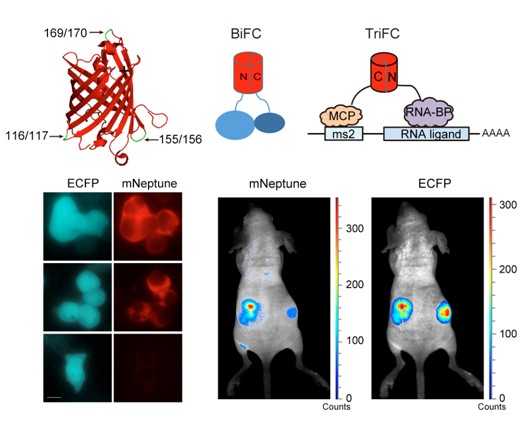Progress in molecular imaging
Date:08-10-2014 | 【Print】 【close】
The research team led by Prof. Cui Zongqiang from Analytical Microbiology and Nano-biology Center in WIV, and Prof. Zhang Xian-En from IBP, recently developed novel far-red mNeptunebased bimolecular fluorescence complementation (BiFC) and trimolecular fluorescence complementation (TriFC) systems with excitation and emission above 600 nm in the ‘tissue optical window’ for imaging protein–protein and RNA–protein interactions in live cells and mice. With these new fluorescence complementation systems, an interaction between PTB and the 3’long terminal repeat region of HIV-1 mRNAs was found and imaged in live cells and mice, implying a role for PTB in regulating HIV-1 mRNA processing. The results have been published in Nucleic Acids Research. The research provides new tools for in vivo imaging of RNA-protein and protein–protein interactions, and adds new insight into the mechanism of HIV-1 mRNA processing in HIV activation from latency.
The Analytical Microbiology and Nano-biology Center, which is headed by Prof. Jiaoyu Deng, is one of the five centers of WIV. The objective of the center is to develop ultra sensitive, high-throughput, rapid, real-time and in vivo analytical technologies for solving fundamental scientific problems of pathogen microbiology/virology and meeting the needs of clinical diagnosis. In recent years, their pioneer researches on bridging nanotechnology and virology create novel analytical tools for fundamental research of human pathogens and clinical diagnostics.
http://nar.oxfordjournals.org/cgi/content/full/gku408?ijkey=JWtbPajFy7VDznu&keytype=ref
